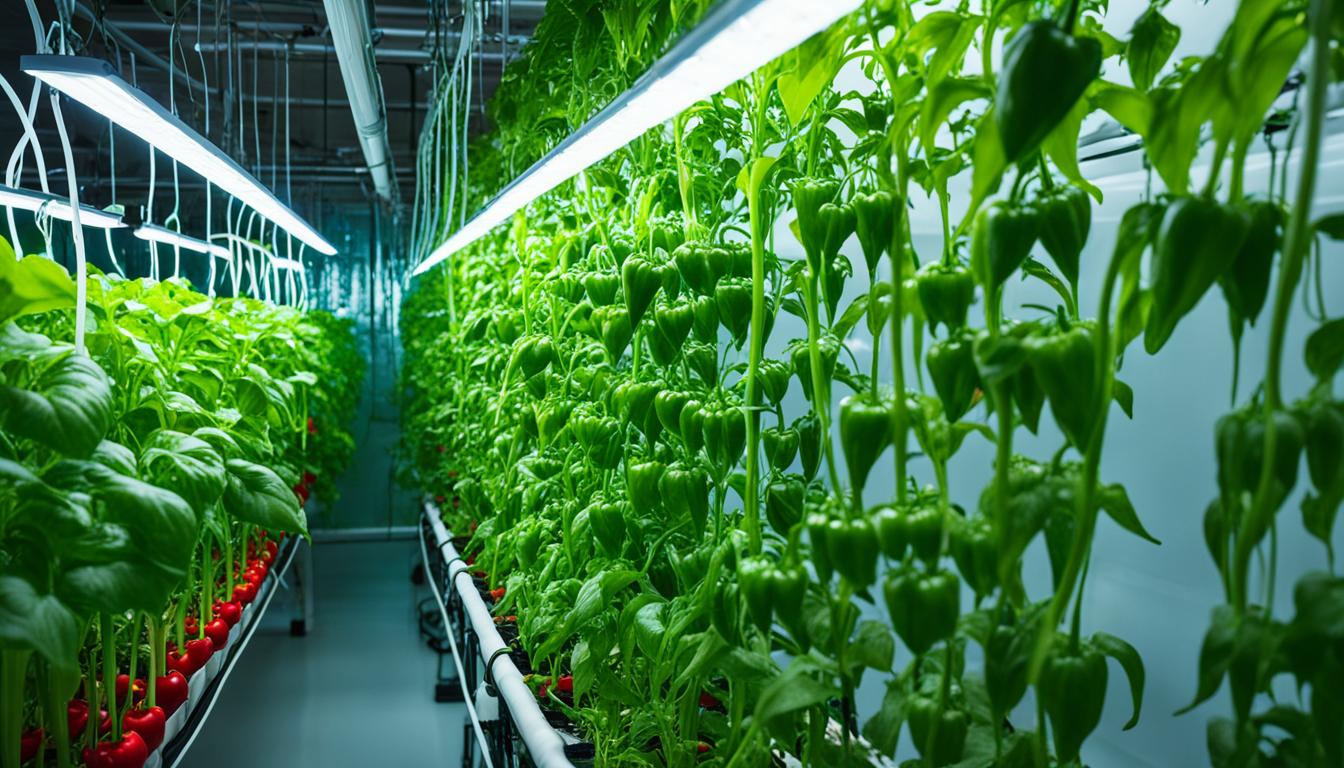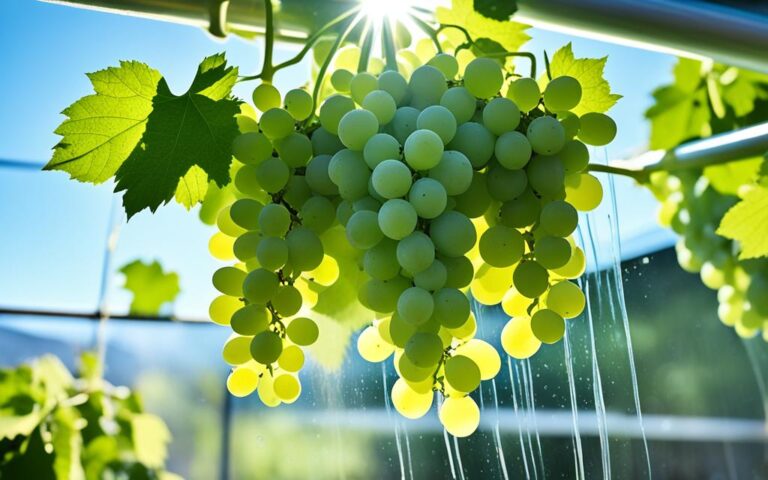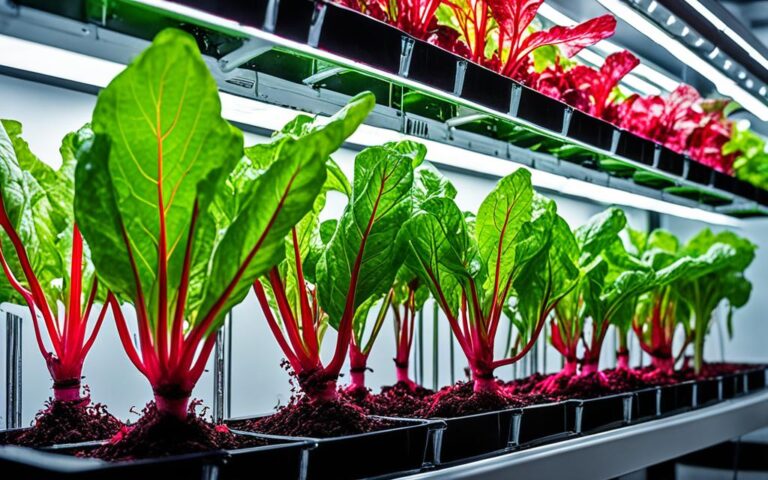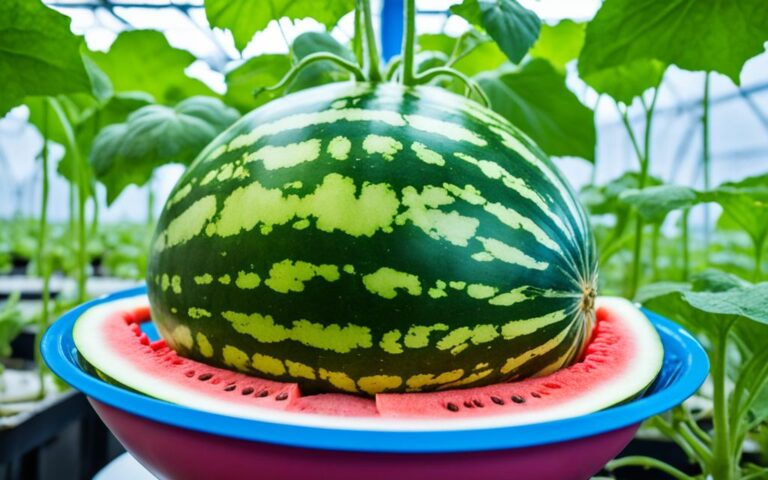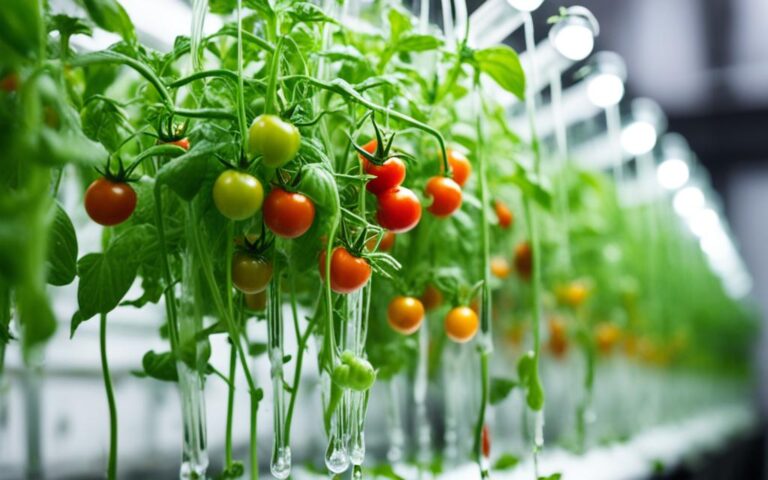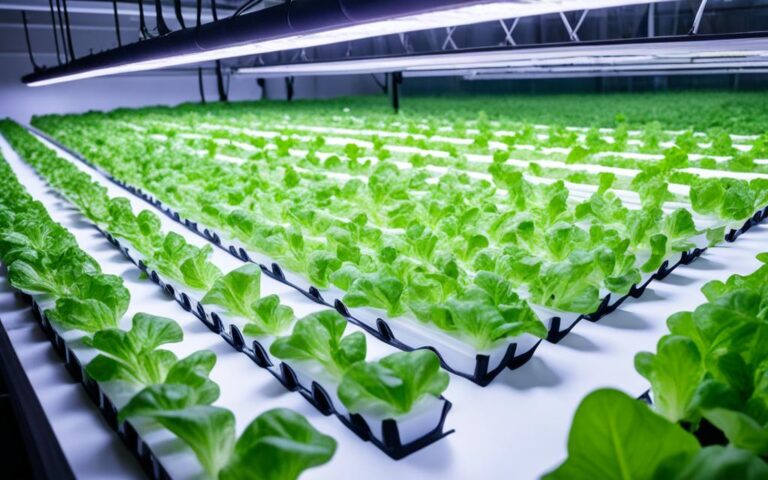Growing Hydroponic Peppers: A Complete Guide
Hydroponics is a way to grow plants without soil. It uses nutrient solutions for water and nutrients. This method lets you grow sweet peppers indoors, avoiding weather and season issues. This guide will show you how to grow sweet peppers indoors with different hydroponic systems.
It includes the Deep Water Culture (DWC) system, great for beginners and experts. You’ll learn about picking seeds, germination, setting up the system, and managing nutrients. It also covers light and temperature needs, pollination, harvesting, and how to get the best yield and taste.
Key Takeaways
- Hydroponic cultivation allows for faster growth and higher yields compared to traditional soil-based systems.
- The Deep Water Culture (DWC) system is a popular and accessible hydroponic method for small-scale growers.
- Careful selection of pepper varieties, nutrient management, and lighting are crucial for successful hydroponic pepper cultivation.
- Hydroponic peppers can be grown year-round, even in winter, making them a versatile choice for indoor farming.
- Proper pollination techniques and pruning can help maximize the yield and flavor of hydroponic peppers.
Table of Contents
Introduction to Hydroponic Pepper Cultivation
Hydroponic cultivation is great for growing peppers. It saves space and cuts down on pests and diseases. This method lets you grow peppers without worrying about the weather or season. Peppers are perfect for hydroponics because they come in many colors, flavors, and are nutritious.
Benefits of Growing Peppers Hydroponically
Hydroponic pepper growing has many advantages. It doesn’t need soil, so it’s perfect for small spaces like city gardens or greenhouses. This method also stops diseases and pests from spreading, making plants healthier and more productive. Plus, peppers get all the nutrients and water they need, which makes them grow faster, taste better, and ripen sooner.
Types of Peppers Suitable for Hydroponic Systems
- Bell Peppers
- Chili Peppers
- Sweet Peppers
- Miniature or Dwarf Peppers
- Thai Peppers
- Paprika Peppers
- Cuban Red Peppers
- Pimento Peppers
Choosing the right pepper variety for hydroponics depends on space, taste, and whether you like sweet or hot peppers. Whether you want to grow big bell peppers, spicy chili peppers, or tiny specialty peppers, hydroponics lets you do it in a controlled way. It’s a great way to grow a variety of peppers sustainably.
“Hydroponic peppers provide an opportunity to enjoy fresh, flavorful produce year-round, even in limited spaces or unfavorable outdoor conditions.”
Selecting the Right Hydroponic System
Choosing the right hydroponic system is key for growing hydroponic peppers. There are many systems, each with its own benefits. Let’s look at some popular ones to find the best for your pepper plants.
Deep Water Culture (DWC) System
The DWC system is easy and effective for growing hydroponic peppers. Plants hang in a tank filled with nutrients, getting plenty of oxygen and growing fast. It’s great for beginners and can handle different plant sizes and amounts.
Nutrient Film Technique (NFT) System
The NFT system uses a thin film of nutrients flowing over the roots. It’s perfect for light plants like lettuce, spinach, and some peppers. This method is efficient with nutrients and water, making it great for indoor farming and controlled growing.
Drip System
The Drip System sends nutrients straight to each plant’s roots through tubes and emitters. It works well with various plant sizes and amounts. This system is precise with nutrients and water, ideal for growing hydroponic peppers indoors or in small spaces.
When picking a hydroponic system, think about your growing space size, how much upkeep you can handle, and your pepper varieties’ needs. By looking at each system’s pros and cons, you can choose the best one for your hydroponic pepper garden.
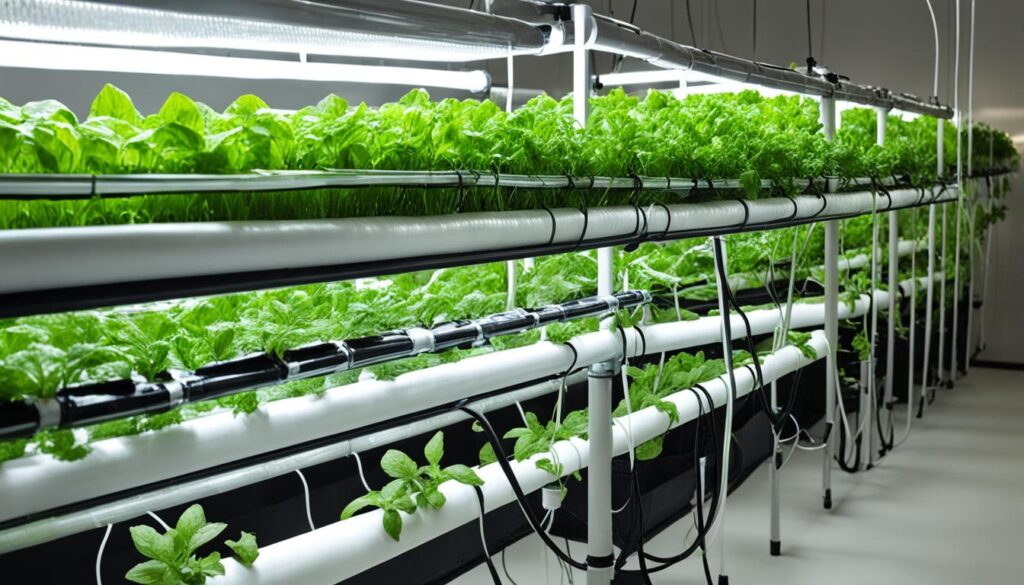
“Choosing the right hydroponic system is like finding the perfect puzzle piece – it needs to fit your growing space, your gardening expertise, and the unique needs of your pepper plants.”
Choosing the Best Pepper Varieties
When picking pepper varieties for hydroponic gardens, growers have many options. Think about the space you have, the taste you want, and if you prefer sweet or hot peppers. Some top picks for hydroponic pepper growing include:
- Bell Peppers: Try Orange Blaze, Yolo Wonder, Chocolate Beauty, and Purple Beauty for different flavors, from sweet to smoky.
- Chili Peppers: Jalapeños, habaneros, and serranos offer a variety of heat levels, measured in Scoville units.
- Sweet Peppers: Sweet Banana and Cubanelle are sweet and great for salads, salsas, and roasting.
- Miniature or Dwarf Peppers: Mini belle or lunchbox peppers are perfect for small indoor spaces because they grow fast.
- Specialty Peppers: Try Thai peppers, paprika peppers, Cuban red peppers, and pimento peppers for something different.
Choosing which pepper varieties to grow depends on what you like, the space you have, and how you plan to use the peppers. By picking a mix of different peppers, hydroponic gardeners can have a wide variety all season long.
| Pepper Variety | Scoville Heat Units |
|---|---|
| Bell Pepper | 0 |
| Banana Pepper | 0–500 |
| Shishito | 50 to 200 |
| Anaheim Pepper | 500 to 2,500 |
| Poblano Pepper | 1,000 to 2,000 |
| Jalapeño Pepper | 3,500 to 8,000 |
| Purple Super Hots | 4,000 – 8,000 |
| Red Fire Chili | 5,000 to 30,000 |
| Cayenne Pepper | 30,000 to 50,000 |
| Thai Chili Peppers | N/A (not specified) |
“The beauty of hydroponic pepper cultivation is the ability to grow a diverse array of varieties, from sweet bell peppers to fiery chili peppers, all within the controlled environment of an indoor or greenhouse setting.”
Setting Up Your Hydroponic System
DIY Deep Water Culture (DWC) System
Building a DIY Deep Water Culture (DWC) hydroponic system for peppers is easy and budget-friendly. This method suspends plants in a water solution full of nutrients. An air pump adds oxygen to the roots. It’s perfect for both new and seasoned hydroponic growers.
To start a DIY DWC system, gather these basic items:
- A sturdy, food-grade plastic container or bucket as the hydroponic container
- Net pots or grow cups for the growing medium, like Rockwool or perlite
- An air pump and air stone for oxygen in the nutrient solution
- A pH testing kit to keep the pH right, between 5.5-6.8
- An LED grow light if your indoor area lacks enough natural light
For a DWC system to work well, balance nutrients, pH, and oxygen in the water is crucial. Keep an eye on these levels and make adjustments as needed for your hydroponic peppers to grow strong.
| Metric | Optimal Range |
|---|---|
| Time to Harvest | ~3 months |
| Light | Best with 16 hours of artificial light |
| EC Range | Keep EC above 2.0 for best growth |
| pH Range | Keep pH between 5.5 – 6.8 for best growth |
| Temperature Range | Best growth at 75 – 85 degrees |
By sticking to these tips and checking on your DWC system often, you can make a great place for your pepper plants to grow.
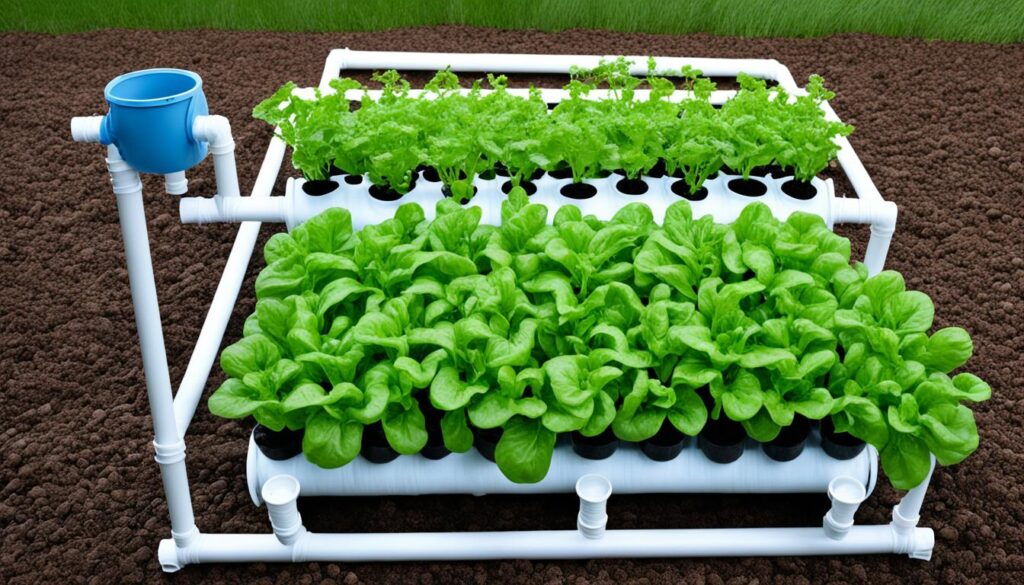
Nutrient Management for Hydroponic Peppers
Getting the nutrients right is key for hydroponic peppers to grow well and produce a lot. Peppers, whether sweet or hot, need the right mix of nutrients to do well without soil. It’s important to know what nutrients they need and how to adjust the nutrient solution’s pH and EC levels for strong plants and lots of peppers.
Essential Nutrients for Pepper Plants
Peppers grown in hydroponics need these main nutrients:
- Nitrogen (N) – Helps with leaf growth and keeps the plant strong.
- Phosphorus (P) – Helps roots grow, flowers bloom, and peppers form.
- Potassium (K) – Makes plants more resistant to disease, helps them handle drought, and stay healthy.
- Calcium (Ca) – Important for cell walls and stops blossom end rot.
- Magnesium (Mg) – Helps make chlorophyll and activate enzymes.
- Iron (Fe) – Needed for making chlorophyll and healthy leaves.
Peppers also need smaller amounts of nutrients like boron, manganese, zinc, and molybdenum.
Adjusting pH and EC Levels
Keeping the right pH and EC levels in the nutrient solution is crucial for pepper plants. For sweet peppers, the EC should be between 2.0 and 2.5 mS/cm. Hot peppers can handle up to 3.5 mS/cm. The pH should be between 5.5 and 6.5 for the best nutrient uptake.
It’s important to check and adjust the pH and EC levels often. This is because the plants grow, the environment changes, and the water quality can vary. By managing the nutrients well, growers can make sure their hydroponic peppers get what they need for great growth, lots of peppers, and top quality.
“Proper nutrient management is the foundation for successful hydroponic pepper cultivation, as it directly impacts the plant’s health, yield, and overall quality.”
Germinating and Propagating Pepper Seeds
Cultivating hydroponic peppers begins with successful pepper seed germination. Using rockwool cubes is a top choice for hydroponic seed starting and seed propagation. These cubes create a perfect spot for seedling preparation and early growth.
Preparing Rockwool Cubes for Germination
First, soak the rockwool cubes in pH-balanced water to make them fully saturated. Then, make small indents in the cubes for the pepper seeds. Place the seeds in these spots, cover the tray, and keep it warm and humid. This is key for pepper seed germination.
Germination times differ by pepper type. For instance, bell peppers sprout in 7-10 days. Cayenne peppers take 16-20 days, and habanero peppers might need 1-5 weeks.
When seedlings have two true leaves, they’re ready for the hydroponic system. This is a big step in seed propagation.
| Pepper Variety | Germination Time |
|---|---|
| Bell Pepper | 10 days |
| Cayenne Pepper | 16-20 days |
| Jalapeno Pepper | 2-3 weeks |
| Habanero Pepper | 1-5 weeks |
| Piquillo Pepper | 2-6 weeks |
Knowing the germination needs of various peppers helps growers improve their hydroponic seed starting. It ensures a smooth move from seed propagation to healthy hydroponic plants.
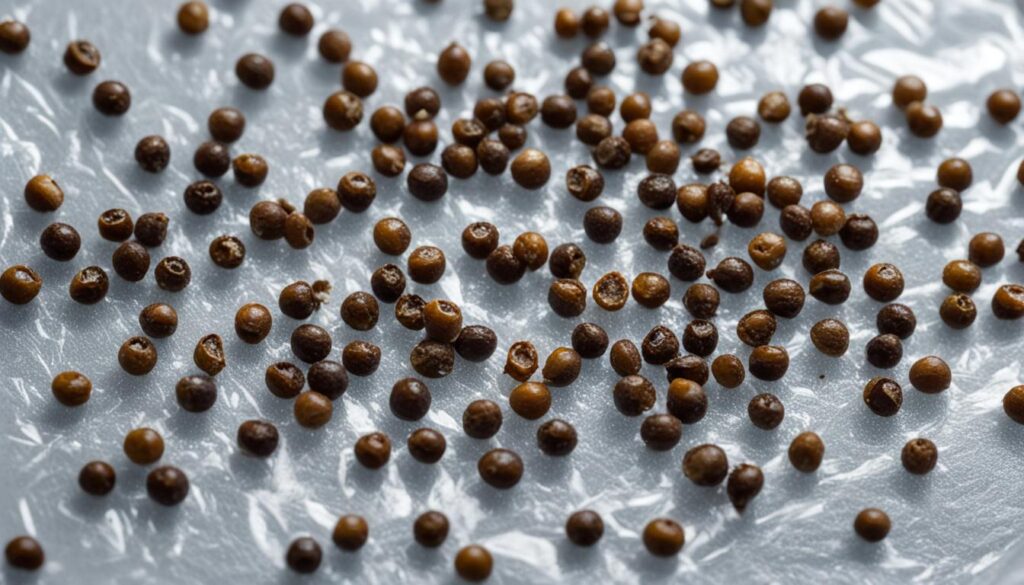
Light and Temperature Requirements
Cultivating hydroponic peppers needs careful attention to their light and temperature needs. These factors are key for healthy growth, flowering, and fruiting.
Optimal Light Intensity and Duration
Hydroponic pepper plants do well with lots of light, about 14-16 hours a day. LED grow lights are great for indoor setups because they meet the hydroponic pepper light requirements and save energy.
The best light intensity for peppers, especially hot ones, is 6-12 hours of direct sunlight or LED grow lights. Keeping the right light duration and intensity helps with growth, flowering, and fruiting.
Temperature Control
Proper temperature control is also key for growing hydroponic peppers. The ideal temperature range is 75°F to 85°F (24°C to 29°C), especially for hot peppers.
Keeping the temperature range right is vital for plant growth factors and health. Big temperature changes can hurt the indoor lighting and how well the pepper plants do.
| Parameter | Optimal Range |
|---|---|
| Light Duration | 14-16 hours per day |
| Light Intensity | 6-12 hours of direct sunlight or equivalent LED grow lights |
| Temperature | 75°F to 85°F (24°C to 29°C) |
By giving hydroponic pepper plants the right light and temperature conditions, growers can help them grow, flower, and produce fruit well. This leads to a great harvest.
Pruning and Training hydroponic Peppers
For hydroponic pepper plants to grow well, pruning and training are key. These practices help control the plant’s size and shape. They also keep the plant healthy, making the most of the limited space in a hydroponic setup.
Pruning Hydroponic Pepper Plants
Pruning is vital for hydroponic pepper plants. Here are some tips for growth:
- Remove suckers (side shoots) to stop the plant from getting too bushy and to focus energy on fruit.
- Trim lower leaves to improve air flow and stop diseases from spreading.
- Pinch off the terminal buds to make the plant branch out and grow bushier.
By pruning correctly, you keep the plant’s shape, encourage branching, and ensure good air and light flow. This helps the plant grow well.
Trellising and Training Hydroponic Peppers
Training and trellising hydroponic pepper plants also help. Using cages, stakes, or strings guides the plant’s growth. This makes the most of the space and helps air move around the plant.
Training the plants lets growers:
- Shape the plant for better use of space in the hydroponic setup.
- Let more light and air in, which helps prevent pests and diseases.
- Boost pepper production by focusing energy on growing high-quality peppers.
Pruning and training hydroponic pepper plants are key for great growth, using space well, and getting the most yield in a controlled setup.
| Pruning Technique | Benefits |
|---|---|
| Removing suckers | Prevents overly bushy growth, redirects energy to fruit production |
| Trimming lower leaves | Improves air circulation, reduces disease susceptibility |
| Pinching off terminal buds | Encourages branching and a more compact, bushy growth habit |
“Proper pruning and training of hydroponic pepper plants can increase yields by up to 50% compared to unpruned plants.”
With a good pruning and training plan, hydroponic pepper growers can make their plants grow better. They can use space well and get great yields in a controlled setting.
Pollination Techniques for Pepper Plants
Hydroponic pepper plants can pollinate themselves, but using simple techniques can boost fruit set and increase your pepper yield.
Self-Pollination
Shaking the plant’s branches or flowers gently is a simple way to pollinate hydroponic peppers. This method works well in indoor settings with little air movement.
Manual Pollination
For better pollination, try manual techniques. Use a soft-bristled brush or cotton swab to move pollen from one flower to another. Do this in the afternoon when pollen is plentiful.
Be gentle when pollinating to avoid harming the flowers. Use different brushes or swabs for each pepper type to keep them pure.
Improving Air Circulation
Good air flow helps pepper plants pollinate better. A small fan near the plants can spread pollen and aid pollination.
Using self-pollination, manual techniques, and fans can help your hydroponic pepper plants pollinate well and yield more.
| Pollination Technique | Benefits | Considerations |
|---|---|---|
| Self-Pollination | Easy to implement No additional equipment required | May not be as reliable as manual pollination Dependent on air circulation |
| Manual Pollination | Ensures successful pollination Maximizes fruit set | Requires more time and effort Need to avoid damaging flowers Separate tools for each variety |
| Improving Air Circulation | Enhances natural pollination process Complements other techniques | Requires additional equipment (fans) Ensures proper air flow in the growing space |
Using these pollination methods together can help hydroponic pepper plants pollinate well and produce a lot of peppers.
“Proper pollination is key for high yields in hydroponic pepper growing. Growers who put in the effort to pollinate by hand often get a big pepper harvest.”
Common Issues and Troubleshooting
Growing hydroponic peppers can be tricky, but you can handle common challenges well. Let’s look at the main problems you might face and how to fix them.
Identifying and Treating Pests and Diseases
Hydroponic pepper plants face pests like aphids, whiteflies, and spider mites. These pests can harm your plants, slowing growth and cutting yield. It’s key to check your plants often and use organic pest control methods or beneficial insects to keep them healthy.
Diseases like powdery mildew and root rot can hit hydroponic peppers too. Keeping your plants clean, ensuring good air flow, and watching them closely can stop these diseases. If you see problems, isolate sick plants and treat them with the right fungicides or remedies to stop the spread.
Addressing Nutrient Deficiencies
Getting the right balance of nutrients is vital for your hydroponic peppers to grow well. Nutrient deficiencies can cause problems like slow growth, leaves that don’t look right, and fewer peppers. Check the nutrient solution’s pH and EC levels often, and adjust them as needed, to make sure your plants get what they need.
| Nutrient Deficiency | Symptoms | Recommended Action |
|---|---|---|
| Nitrogen (N) Deficiency | Older leaves turn yellow, growth slows | Increase nitrogen in the nutrient solution |
| Phosphorus (P) Deficiency | Leaves turn purple or reddish, stunted growth | Increase phosphorus in the nutrient solution |
| Potassium (K) Deficiency | Leaf edges and tips turn yellow or brown, weak stems | Increase potassium in the nutrient solution |
By keeping an eye out and fixing nutrient deficiencies, pest problems, or diseases quickly, you can keep your hydroponic pepper garden healthy. This way, you’ll get a great harvest.
Harvesting and Storing Hydroponic Peppers
Harvesting and storing your hydroponic peppers right is key to keeping them fresh. Knowing when and how to handle them after harvest is crucial. This ensures you get to enjoy your hard work for a long time.
Timing the Harvest
Hydroponic peppers are ready to pick about 3 months after planting. They should be fully grown and have their best taste and smell. For green peppers, check their size to know when they’re ready. For colored peppers, wait until they turn deep in color.
Proper Handling Techniques
When picking your hydroponic peppers, be gentle to avoid damage. Use clean scissors or pruners to cut them from the plant, leaving a bit of stem. This careful handling helps keep the peppers fresh and whole.
Short-Term Storage
You can keep your hydroponic peppers in the fridge for up to two weeks. Put them in a bag with holes or a sealed container to keep them fresh. Don’t wash them before storing to avoid mold.
Long-Term Preservation
To keep peppers for longer, freeze them. Clean and remove stems and seeds, then prepare them as you like. Lay them out to freeze, then move them to a container or bag in the freezer. Frozen, they can last for months.
| Pepper Storage Method | Shelf Life |
|---|---|
| Refrigerator | Up to 2 weeks |
| Freezer | Several months |
By using these tips for harvesting and storing hydroponic peppers, you can enjoy your homegrown produce for a long time. You’ll get to savor the fresh taste and nutrition of your peppers.
Tips for Maximizing Yield and Flavor
To grow lots of tasty hydroponic peppers, there are key steps to follow. Keeping the right levels of nutrients, pH, and EC in the system is key. This helps plants grow strong and produce lots of fruit. Also, pruning and training plants right makes them focus on making more peppers.
Right light and temperature are also important. They make the peppers taste better, especially the hot ones. By controlling the environment, growers can make their hydroponic pepper plants do their best. This means more peppers and better taste.
Nutrient and Environmental Optimization
Getting the nutrients, pH, and EC just right is crucial for growing hydroponic peppers. Growers need to check and adjust these often to help their plants grow and produce fruit well. Also, the right temperature and light can make the peppers taste better.
Pruning and Training Techniques
Pruning and training hydroponic peppers can really help with yield and taste. By cutting back on unnecessary leaves and guiding the plant, growers can make the plant focus on making more peppers. This leads to bigger, tastier peppers.
Companion Planting and Urban Farming
For those with little space, like in cities, using companion planting and urban farming is smart. Plants like basil, tomatoes, and parsley can make peppers taste better and keep pests away. With the right methods, even small hydroponic setups can give a big pepper harvest.
| Optimization Technique | Benefit |
|---|---|
| Nutrient Management | Promotes robust plant growth and fruit production |
| pH and EC Adjustment | Ensures optimal nutrient absorption and availability |
| Light and Temperature Control | Enhances flavor, pungency, and overall plant health |
| Pruning and Training | Directs plant’s energy towards fruit development |
| Companion Planting | Improves flavor, repels pests, and enables urban farming |
Using these strategies, hydroponic pepper growers can make the most of their plants. This leads to a great harvest with lots of peppers that taste amazing.
“Mastering the art of hydroponic pepper cultivation requires a delicate balance between nutrient management, environmental control, and strategic pruning. The rewards, however, are bountiful and flavorful peppers that tantalize the senses.”
Conclusion
Growing hydroponic peppers is a rewarding way to have fresh, nutritious produce all year. It doesn’t matter about the weather or season. By picking the right pepper types and managing the growing conditions and nutrients, you can get a lot of tasty peppers at home. This method also helps with sustainable food production and self-sufficiency.
Indoor gardening and controlled environment agriculture let growers control their food supply. They get a steady and high-quality pepper supply. Whether it’s a simple or complex system, hydroponics fits many growers’ needs. By choosing the right pepper types and managing the environment well, growers can fully enjoy this rewarding way to grow food.
The need for fresh, local produce is growing. Hydroponic pepper growing offers many benefits like year-round produce, less environmental harm, and growing in small spaces. It’s a great choice for both new and experienced gardeners. By using hydroponic pepper growing, people and communities can move towards more self-sufficiency and a sustainable food future.
